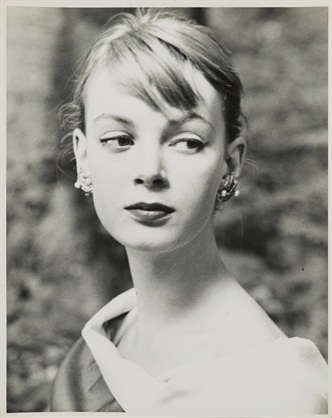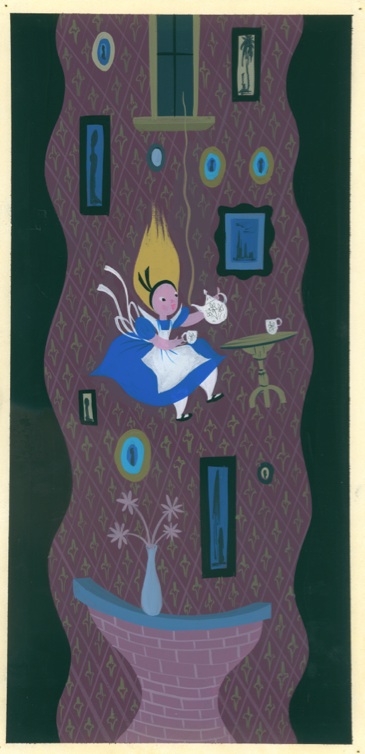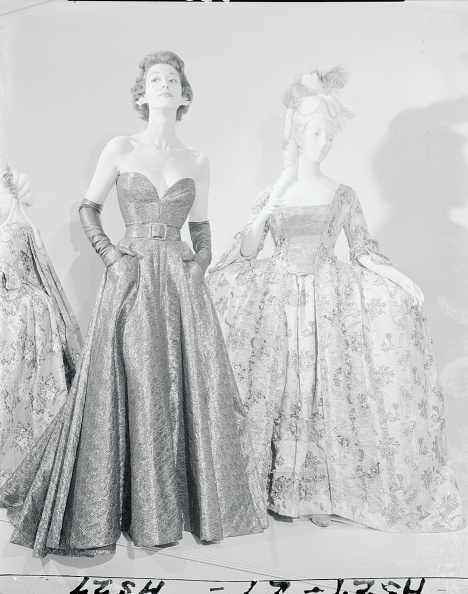![Isabella Albonico photographed by Leombruno-Bodi in Dior pattern 1471 for Vogue, January 1st, 1960]()
Detail of Vogue 1471 by Yves Saint Laurent for Christian Dior, Vogue, January 1, 1960. Photo: Leombruno-Bodi.
For Paco Peralta.
Before Vogue Patterns introduced Yves Saint Laurent with patterns from the Mondrian collection, the company had already licensed the designer’s work for the house of Dior. (Read more at the Fondation Pierre Bergé – Yves Saint Laurent, or see Dustin’s post here.)
Yves Saint Laurent was appointed head designer at Dior after Christian Dior’s death in 1957. Dior had been his mentor; in 1955 he hired Saint Laurent to work at his new boutique, later promoting him to accessories and couture. Richard Avedon’s famous Dovima with Elephants shows a velvet evening dress designed by Yves Saint Laurent while he was still assistant designer:
![Avedon's Dovima with Elephants and YSL sketch for Dior, 1955]()
Richard Avedon, Dovima with Elephants, Evening Dress by Dior, Cirque d’Hiver, Paris, 1955, and sketch by Yves Saint Laurent.
(Images via Enticing the Light and Encore! Life.)
Saint Laurent’s first collection for Dior, Trapèze (Spring 1958 haute couture), was a huge success, and his later work at the house continued its play with proportion. L’Officiel’s spring preview issue for 1958 featured an illustration of a Dior trapeze dress by René Gruau:
![L'Officiel mars 1958: Gruau illustration of a black Dior trapeze dress]()
Christian Dior trapeze dress on the cover of L’Officiel, March 1958. Illustration: René Gruau. Image via jalougallery.com.
The young Yves Saint Laurent designed six haute couture collections for Dior; Vogue’s licensing represents his last three collections for the house, from 1959 to 1960.
![Christian Dior label, fall-winter 1959 at the Metropolitan Museum of Art]()
Christian Dior label, automne-hiver 1959. Image via the Metropolitan Museum of Art.
1. Christian Dior Haute Couture Fall/Winter 1959
Saint Laurent’s second Fall/Winter couture collection for Dior was controversial; L’Officiel declared its aesthetic “femininity pushed to the extreme.” Suits were shown with severely cropped jackets, and the skirt silhouettes included voluminous tiers and hobble skirts.
The first Dior patterns were promoted with illustrations by Esther Larson in the late 1959 issues of Vogue Pattern Book and Vogue Printed Pattern News (thanks to the White Cabinet for the ID):
![Vogue 1472 on the cover of Vogue Pattern news for December 15th, 1959]()
Vogue Printed Pattern News, December 15, 1959. Illustration: Esther Larson.
Anticipating demand for this high-profile addition to Vogue’s designer patterns, Vogue Pattern Book noted that the new patterns would be available in stores after November 10th:
![]()
Dior patterns in Vogue Pattern Book, December 1959-January 1960. Illustrations: Esther Larson. Image via Make Mine Vogue.
The first Dior patterns were photographed by Joseph Leombruno and Jack Bodi, the couple who worked as Leombruno-Bodi. In Vogue magazine’s first issue for 1960, Isabella Albonico modelled the two dress ensembles, Vogue 1471 and 1470:
![For the first time Vogue patterns from designs by Dior. Vogue 1 Jan 1960]()
Vogue patterns from designs by Dior, Vogue, January 1, 1960. Photos: Leombruno-Bodi.
Leombruno-Bodi also photographed the new Dior patterns for Ladies’ Home Journal. The accompanying text for Vogue 1470 suggests that the hobble skirt silhouette was considered extreme: “Dior’s famous ‘hobble’ skirt makes a charming mid-season costume … The pattern also includes details on how to make the dress without the band at the bottom of the skirt for less extreme effect.” The model on the left is Anne St. Marie (click to enlarge):
![Nora O'Leary, "Christian Dior: Yours for the Making," with hats by Vincent-Harmik, Maria Pia, and John Frederics - Ladies' Home Journal Jan 1960]()
Nora O’Leary, “Christian Dior: Yours for the Making,” Ladies’ Home Journal, January 1960. Photos: Leombruno-Bodi. Image via the Internet Archive.
Vogue 1470 is a striking dress and jacket ensemble. The short jacket has three-quarter sleeves and bow trim at the waist, while the dress has short sleeves, low V-neckline, and the collection’s distinctive pouf-hobble skirt banded at the knee. The original was navy tweed:
![1950s Christian Dior dress and jacket pattern - Vogue 1470]()
Vogue 1470 by Yves Saint Laurent for Christian Dior (1959) Dress and jacket.
Here’s the envelope description: One piece dress and jacket. Skirt, with or without puffed tunic, joins the bodice at the waistline. Wide V neck-line with band finish. Short kimono sleeves. Short fitted jacket, joined to waistband, has concealed fastening below notched collar; below elbow length sleeves. Novelty belt.
Vogue 1471 is a close-fitting, double-breasted jacket with matching dress. The original was black-and-white tweed:
![1950s Christian Dior dress and jacket pattern - Vogue 1471]()
Vogue 1471 by Yves Saint Laurent for Christian Dior (1959) Image via Make Mine Vogue.
The envelope description reads: One piece dress and jacket. Flared skirt joins the bodice at the waist-line. Single button closing below the wide V neck-line with extension band finish. Above elbow length and short sleeves. Double breasted jacket has notched collar and below elbow length sleeves. Novelty belt for version A.
Vogue 1472 seems to have been the most popular of the three patterns. The voluminous coat and skirt suit were modelled by Nena von Schlebrügge:
![1950s Christian Dior coat and suit pattern - Vogue 1472]()
Vogue 1472 by Yves Saint Laurent for Christian Dior (1959) Image via the Vintage Patterns Wiki.
Here’s the envelope description: Coat, suit and scarf. Double-breasted hip length jacket has a notched collar and below elbow length sleeves with buttoned vents. Slim skirt. Double-breasted, full coat in two lengths has a large shaped collar. Concealed pocket in side seams. Below elbow length sleeves joined to dropped shoulder armholes. Straight scarf.
In the next issue of Vogue Pattern Book, the Vogue 1472 coat is called “the newsmaking original Dior coat that tops the suit… Note the extras here: the enormous buttons, the slashed side seams, the stitched collar, the scarf to match. Your own extra: a towering cloche of the checked fabric”:
![Photo of Nena von Schlebrügge in Vogue 1472 in Vogue Pattern Book Feb/Mar 1960]()
Vogue 1472 in Vogue Pattern Book, February/March 1960. Image via eBay.
2. Christian Dior Haute Couture Spring/Summer 1960
Saint Laurent’s Spring 1960 collection for Dior was characterized by rounded silhouettes and vibrant colour. L’Officiel noted its straight suits with jackets cut on the bias to achieve the suppleness of a knitted cardigan.
Vogue 1012, introduced in the August/September 1960 issue of Vogue Pattern Book, includes a collarless, single-breasted skirt suit and sleeveless blouse with crisscross back. The jacket in view A is cut on the bias:
![1960s Christian Dior suit and blouse pattern - Vogue 1012]()
Vogue 1012 by Yves Saint Laurent for Christian Dior (1960) Image via the Vintage Patterns Wiki.
The envelope description reads: Suit and blouse. Short, straight jacket buttons below collarless away from normal neck-line. Welt pockets. Below elbow length kimono sleeves. Skirt has soft gathers from very shallow yoke. Easy fitting overblouse has shoulder straps crisscrossed at back.
This suit is similar to Vogue 1012, but has a more conventional button front:
![L'Officiel 457-58 Dior]()
Christian Dior’s pared-down suit, L’Officiel, April 1960. Photo: Philippe Pottier. Image via jalougallery.com.
These Guy Arsac editorial photos of a red “boule” coat and teal dress show the collection’s play with colour and silhouette:
![L'Officiel 455-56 Dior Arsac]()
“Boule” coat by Christian Dior, L’Officiel, March 1960. Photo: Guy Arsac. Image via jalougallery.com.
![LOfficiel 457-58 Diorb]()
Silk dress by Christian Dior, L’Officiel, April 1960. Photo: Guy Arsac. Image via jalougallery.com.
3. Christian Dior Haute Couture Fall/Winter 1960
Yves Saint Laurent’s controversial final collection for Dior, le Beat look, was inspired by Left Bank icon Juliette Gréco and the Beatniks of Saint-Germain-des-Prés. It was innovative for its infusion of youthful, bohemian street style into the couture, with Beat elements including leather jackets, knitted turtlenecks, and plenty of black.
Vogue produced two patterns from this collection, drawn from the more conventional designs. Vogue 1041 is a skirt suit and matching, loose coat with a big standing collar and side slits:
![1960s Christian Dior suit and coat pattern - Vogue 1041]()
Vogue 1041 by Christian Dior (1960) Image via the Vintage Patterns Wiki.
Here’s the envelope description: Suit and coat. Easy fitting jacket has high buttoned closing below neck-band. Vent opening in side front seams. Bracelet length and elbow length sleeves. Slightly gathered skirt has outside stitched front panel concealing pockets. Seven eighths length loose coat has opening in side seams. Away-from-neck-line standing neck-band. Bracelet length kimono sleeves.
Philippe Pottier photographed the purple coat ensemble for L’Officiel‘s winter collections issue:
![Christian Dior tweed ensemble photographed by Philippe Pottier for L'Officiel octobre 1960]()
Christian Dior tweed ensemble, L’Officiel, October 1960. Photo: Philippe Pottier. Image via jalougallery.com
Vogue 1041 was photographed for Vogue magazine by Henry Clarke:
![Vogue 1041 by Dior photographed by Henry Clarke - Vogue Nov 15th, 1960]()
Vogue 1041 in Vogue, November 15, 1960. Photo: Henry Clarke.
![Vogue 1041 by Dior photographed by Henry Clarke - Vogue Nov 15th, 1960]()
Vogue 1041 in Vogue, November 15, 1960. Photo: Henry Clarke.
Vogue 1049 is a skirt suit and sleeveless overblouse. The blouse is worn over a barrel skirt with attached underbodice for a dropped-waist effect. The jacket of view A is designed to be worn open:
![1960s Christian Dior suit pattern - Vogue 1049]()
Vogue 1049 by Yves Saint Laurent for Christian Dior (1961) Image via Etsy.
The envelope description reads: Suit and blouse. Box jacket has cut away fronts and simulated buttoned closing or complete buttoned closing, below standing band collar. Easy fitting overblouse with optional tied belt has bateau neck-line. Above elbow length sleeves and sleeveless. Slightly barrelled shaped skirt attached to bodice.
The dotted black ensemble in duchesse velvet was photographed for this Chatillon Mouly Roussel advertisement in L’Officiel:
![Ensemble de Christian Dior en duchesse velours de Chatillon Mouly Roussel]()
Chatillon Mouly Roussel ad showing an ensemble by Christian Dior, L’Officiel, October 1960. Image via jalougallery.com.
I also found the black suit in a later L’Officiel composite:
![A Dior suit by Yves Saint Laurent - Dior 1000modèles Beat]()
A Dior suit by Yves Saint Laurent, L’Officiel 1000 modèles no. 81 (2007). Image via jalougallery.com.
These William Klein editorial photos featuring Dior Fall 1960 designs capture the Beat collection’s youthful spirit:
![Dorothea McGowan and Sara Thom in Dior, with Little Bara, photographed for Vogue by WIlliam Klein]()
Dorothea McGowan and Sara Thom in Dior, with Little Bara. Vogue, September 1960. William Klein. Image via Pleasurephoto.
![Dorothea McGowan in Dior, with Little Bara, photographed for Vogue by WIlliam Klein]()
Dorothea McGowan in Christian Dior. Vogue, September 1960. Photo: William Klein. Image via the Fashion Spot.
For more of Yves Saint Laurent’s work for Dior see L’Officiel 1000 modèles’ Dior special issue.
Tagged:
1950s,
1960s,
Christian Dior,
couture,
designer,
fashion,
fashion photography,
illustration,
sewing,
vintage,
Vogue Patterns,
Yves Saint Laurent ![]()
![]()
![]()
![]()
![]()
![]()
![]()
![]()



























































































































































































































